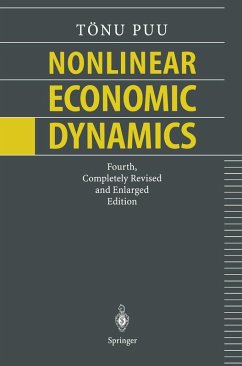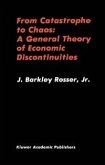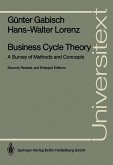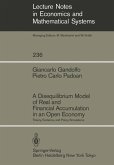Tönu Puu
Nonlinear Economic Dynamics (eBook, PDF)
40,95 €
40,95 €
inkl. MwSt.
Sofort per Download lieferbar

20 °P sammeln
40,95 €
Als Download kaufen

40,95 €
inkl. MwSt.
Sofort per Download lieferbar

20 °P sammeln
Jetzt verschenken
Alle Infos zum eBook verschenken
40,95 €
inkl. MwSt.
Sofort per Download lieferbar
Alle Infos zum eBook verschenken

20 °P sammeln
Tönu Puu
Nonlinear Economic Dynamics (eBook, PDF)
- Format: PDF
- Merkliste
- Auf die Merkliste
- Bewerten Bewerten
- Teilen
- Produkt teilen
- Produkterinnerung
- Produkterinnerung

Bitte loggen Sie sich zunächst in Ihr Kundenkonto ein oder registrieren Sie sich bei
bücher.de, um das eBook-Abo tolino select nutzen zu können.
Hier können Sie sich einloggen
Hier können Sie sich einloggen
Sie sind bereits eingeloggt. Klicken Sie auf 2. tolino select Abo, um fortzufahren.

Bitte loggen Sie sich zunächst in Ihr Kundenkonto ein oder registrieren Sie sich bei bücher.de, um das eBook-Abo tolino select nutzen zu können.
This book deals with the effects of nonlinearity on dynamic economic models. Topics from both micro- and macroeconomics are dealt with. The text is illustrated by extensive illustrations.
- Geräte: PC
- ohne Kopierschutz
- eBook Hilfe
- Größe: 29.25MB
Andere Kunden interessierten sich auch für
![From Catastrophe to Chaos: A General Theory of Economic Discontinuities (eBook, PDF) From Catastrophe to Chaos: A General Theory of Economic Discontinuities (eBook, PDF)]() J. Barkley RosserFrom Catastrophe to Chaos: A General Theory of Economic Discontinuities (eBook, PDF)112,95 €
J. Barkley RosserFrom Catastrophe to Chaos: A General Theory of Economic Discontinuities (eBook, PDF)112,95 €![From Catastrophe to Chaos: A General Theory of Economic Discontinuities (eBook, PDF) From Catastrophe to Chaos: A General Theory of Economic Discontinuities (eBook, PDF)]() J. Barkley RosserFrom Catastrophe to Chaos: A General Theory of Economic Discontinuities (eBook, PDF)152,95 €
J. Barkley RosserFrom Catastrophe to Chaos: A General Theory of Economic Discontinuities (eBook, PDF)152,95 €![The Elements of a Nonlinear Theory of Economic Dynamics (eBook, PDF) The Elements of a Nonlinear Theory of Economic Dynamics (eBook, PDF)]() Carl ChiarellaThe Elements of a Nonlinear Theory of Economic Dynamics (eBook, PDF)40,95 €
Carl ChiarellaThe Elements of a Nonlinear Theory of Economic Dynamics (eBook, PDF)40,95 €![Operator Theorems with Applications to Distributive Problems and Equilibrium Models (eBook, PDF) Operator Theorems with Applications to Distributive Problems and Equilibrium Models (eBook, PDF)]() Antonio VillarOperator Theorems with Applications to Distributive Problems and Equilibrium Models (eBook, PDF)40,95 €
Antonio VillarOperator Theorems with Applications to Distributive Problems and Equilibrium Models (eBook, PDF)40,95 €![Business Cycle Theory (eBook, PDF) Business Cycle Theory (eBook, PDF)]() Günter GabischBusiness Cycle Theory (eBook, PDF)40,95 €
Günter GabischBusiness Cycle Theory (eBook, PDF)40,95 €![A Disequilibrium Model of Real and Financial Accumulation in an Open Economy (eBook, PDF) A Disequilibrium Model of Real and Financial Accumulation in an Open Economy (eBook, PDF)]() Giancarlo GandolfoA Disequilibrium Model of Real and Financial Accumulation in an Open Economy (eBook, PDF)40,95 €
Giancarlo GandolfoA Disequilibrium Model of Real and Financial Accumulation in an Open Economy (eBook, PDF)40,95 €![The Visible Hand (eBook, PDF) The Visible Hand (eBook, PDF)]() Reiner B. KobloThe Visible Hand (eBook, PDF)40,95 €
Reiner B. KobloThe Visible Hand (eBook, PDF)40,95 €-
-
-
This book deals with the effects of nonlinearity on dynamic economic models. Topics from both micro- and macroeconomics are dealt with. The text is illustrated by extensive illustrations.
Dieser Download kann aus rechtlichen Gründen nur mit Rechnungsadresse in A, B, BG, CY, CZ, D, DK, EW, E, FIN, F, GR, HR, H, IRL, I, LT, L, LR, M, NL, PL, P, R, S, SLO, SK ausgeliefert werden.
Produktdetails
- Produktdetails
- Verlag: Springer Berlin Heidelberg
- Seitenzahl: 288
- Erscheinungstermin: 6. Dezember 2012
- Englisch
- ISBN-13: 9783642607752
- Artikelnr.: 53334028
- Verlag: Springer Berlin Heidelberg
- Seitenzahl: 288
- Erscheinungstermin: 6. Dezember 2012
- Englisch
- ISBN-13: 9783642607752
- Artikelnr.: 53334028
- Herstellerkennzeichnung Die Herstellerinformationen sind derzeit nicht verfügbar.
1 Introduction.- 1.1 Dynamics Versus Equilibrium Analysis.- 1.2 Linear Versus Nonlinear Modelling.- 1.3 Perturbation Methods.- 1.4 Structural Stability.- 1.5 Chaos and Fractals.- 1.6 The Choice of Topics Included.- 2 Differential Equations.- 2.1 The Phase Portrait.- 2.2 Linear Systems.- 2.3 Structural Stability.- 2.4 Limit Cycles.- 2.5 The Hopf Bifurcation.- 2.5 The Saddle-Node Bifurcation.- 2.7 Perturbation Methods: Poincaré-Lindstedt.- 2.8 Perturbation Methods: Two-Timing.- 2.9 Forced Oscillators: van der Pol.- 2.10 Forced Oscillators: Duffing.- 2.11 Chaos.- 2.12 A Short History of Chaos.- 3 Iterated Maps.- 3.1 Introduction.- 3.2 The Logistic Map.- 3.3 The Lyapunov Exponent.- 3.4 Symbolic Dynamics.- 3.5 Sarkovskii's Theorem and the Schwarzian Derivative.- 3.6 The Hénon Model.- 3.7 Lyapunov Exponents in 2D.- 3.8 Fractals and Fractal Dimension.- 3.9 The Mandelbrot Set.- 4 Monopoly.- 4.1 Introduction.- 4.2 The Model.- 4.3 Adaptive Search.- 4.4 Numerical Results.- 4.5 Fixed Points and Cycles.- 4.6 Chaos.- 4.7 A Case with Two Products.- 4.8 Discussion.- 5 Duopoly and Oligopoly.- 5.1 Introduction.- 5.2 The Cournot Model.- 5.3 Stackelberg Equilibria.- 5.4 The Iterative Process.- 5.5 Stability of the Cournot Point.- 5.6 Periodic Points and Chaos.- 5.7 Adaptive Expectations.- 5.8 Adjustments Including Stackelberg Points.- 5.9 Oligopoly with Three Firms.- 5.10 Stackelberg Action Reconsidered.- 5.11 The Iteration with Three Oligopolists.- 5.12 Back to "Duopoly".- 5.13 Changing the Order of Adjustment.- 6 Business Cycles: Continuous Time.- 6.1 The Multiplier-Accelerator Model.- 6.2 The Original Model.- 6.3 Nonlinear Investment Functions and Limit Cycles.- 6.4 Limit Cycles: Existence.- 6.5 Limit Cycles: Asymptotic Approximation.- 6.6 Limit Cycles: Transients andStability.- 6.7 The Two-Region Model.- 6.8 The Persistence of Cycles.- 6.9 Perturbation Analysis of the Coupled Model.- 6.10 The Unstable Zero Equilibrium.- 6.11 Other Fixed Points.- 6.12 Properties of Fixed Points.- 6.13 The Arbitrary Phase Angle.- 6.14 Stability of the Coupled Oscillators.- 6.15 The Forced Oscillator.- 6.16 The World Market.- 6.17 The Small Open Economy.- 6.18 Stability of the Forced Oscillator.- 6.19 Catastrophe.- 6.20 Period Doubling and Chaos.- 6.21 Relaxation Cycles.- 6.22 Relaxation: The Autonomous Case.- 6.23 Relaxation: The Forced Case.- 6.24 Three Identical Regions.- 6.25 On the Existence of Periodic Solutions.- 6.26 Stability of Three Oscillators.- 6.27 Simulations.- 7 Business Cycles: Continuous Space.- 7.1 Introduction.- 7.2 Interregional Trade.- 7.3 The Linear Model.- 7.4 Coordinate Separation.- 7.5 The Square Region.- 7.6 The Circular Region.- 7.7 The Spherical Region.- 7.8 The Nonlinear Spatial Model.- 7.9 Dispersive Waves.- 7.10 Standing Waves.- 8 Business Cycles: Discrete Time.- 8.1 Introduction.- 8.2 Investments.- 8.3 Consumption.- 8.4 The Cubic Iterative Map.- 8.5 Fixed Points, Cycles, and Chaos.- 8.6 Formal Analysis of Chaotic Dynamics.- 8.7 Coordinate Transformation.- 8.8 The Three Requisites of Chaos.- 8.9 Symbolic Dynamics.- 8.10 Brownian Random Walk.- 8.11 Digression on Order and Disorder.- 8.12 The General Model.- 8.13 Relaxation Cycles.- 8.14 The Slow Feed Back.- 8.15 The Autonomous Term: Changes of Fixed Points.- 8.16 The Autonomous Term: Response of the Chaotic Process.- 8.17 Lyapunov Exponents and Fractal Dimensions.- 8.18 Non-Relaxation Cycles.- 8.19 Conclusion.- References.
1 Introduction.- 1.1 Dynamics Versus Equilibrium Analysis.- 1.2 Linear Versus Nonlinear Modelling.- 1.3 Perturbation Methods.- 1.4 Structural Stability.- 1.5 Chaos and Fractals.- 1.6 The Choice of Topics Included.- 2 Differential Equations.- 2.1 The Phase Portrait.- 2.2 Linear Systems.- 2.3 Structural Stability.- 2.4 Limit Cycles.- 2.5 The Hopf Bifurcation.- 2.5 The Saddle-Node Bifurcation.- 2.7 Perturbation Methods: Poincaré-Lindstedt.- 2.8 Perturbation Methods: Two-Timing.- 2.9 Forced Oscillators: van der Pol.- 2.10 Forced Oscillators: Duffing.- 2.11 Chaos.- 2.12 A Short History of Chaos.- 3 Iterated Maps.- 3.1 Introduction.- 3.2 The Logistic Map.- 3.3 The Lyapunov Exponent.- 3.4 Symbolic Dynamics.- 3.5 Sarkovskii's Theorem and the Schwarzian Derivative.- 3.6 The Hénon Model.- 3.7 Lyapunov Exponents in 2D.- 3.8 Fractals and Fractal Dimension.- 3.9 The Mandelbrot Set.- 4 Monopoly.- 4.1 Introduction.- 4.2 The Model.- 4.3 Adaptive Search.- 4.4 Numerical Results.- 4.5 Fixed Points and Cycles.- 4.6 Chaos.- 4.7 A Case with Two Products.- 4.8 Discussion.- 5 Duopoly and Oligopoly.- 5.1 Introduction.- 5.2 The Cournot Model.- 5.3 Stackelberg Equilibria.- 5.4 The Iterative Process.- 5.5 Stability of the Cournot Point.- 5.6 Periodic Points and Chaos.- 5.7 Adaptive Expectations.- 5.8 Adjustments Including Stackelberg Points.- 5.9 Oligopoly with Three Firms.- 5.10 Stackelberg Action Reconsidered.- 5.11 The Iteration with Three Oligopolists.- 5.12 Back to "Duopoly".- 5.13 Changing the Order of Adjustment.- 6 Business Cycles: Continuous Time.- 6.1 The Multiplier-Accelerator Model.- 6.2 The Original Model.- 6.3 Nonlinear Investment Functions and Limit Cycles.- 6.4 Limit Cycles: Existence.- 6.5 Limit Cycles: Asymptotic Approximation.- 6.6 Limit Cycles: Transients andStability.- 6.7 The Two-Region Model.- 6.8 The Persistence of Cycles.- 6.9 Perturbation Analysis of the Coupled Model.- 6.10 The Unstable Zero Equilibrium.- 6.11 Other Fixed Points.- 6.12 Properties of Fixed Points.- 6.13 The Arbitrary Phase Angle.- 6.14 Stability of the Coupled Oscillators.- 6.15 The Forced Oscillator.- 6.16 The World Market.- 6.17 The Small Open Economy.- 6.18 Stability of the Forced Oscillator.- 6.19 Catastrophe.- 6.20 Period Doubling and Chaos.- 6.21 Relaxation Cycles.- 6.22 Relaxation: The Autonomous Case.- 6.23 Relaxation: The Forced Case.- 6.24 Three Identical Regions.- 6.25 On the Existence of Periodic Solutions.- 6.26 Stability of Three Oscillators.- 6.27 Simulations.- 7 Business Cycles: Continuous Space.- 7.1 Introduction.- 7.2 Interregional Trade.- 7.3 The Linear Model.- 7.4 Coordinate Separation.- 7.5 The Square Region.- 7.6 The Circular Region.- 7.7 The Spherical Region.- 7.8 The Nonlinear Spatial Model.- 7.9 Dispersive Waves.- 7.10 Standing Waves.- 8 Business Cycles: Discrete Time.- 8.1 Introduction.- 8.2 Investments.- 8.3 Consumption.- 8.4 The Cubic Iterative Map.- 8.5 Fixed Points, Cycles, and Chaos.- 8.6 Formal Analysis of Chaotic Dynamics.- 8.7 Coordinate Transformation.- 8.8 The Three Requisites of Chaos.- 8.9 Symbolic Dynamics.- 8.10 Brownian Random Walk.- 8.11 Digression on Order and Disorder.- 8.12 The General Model.- 8.13 Relaxation Cycles.- 8.14 The Slow Feed Back.- 8.15 The Autonomous Term: Changes of Fixed Points.- 8.16 The Autonomous Term: Response of the Chaotic Process.- 8.17 Lyapunov Exponents and Fractal Dimensions.- 8.18 Non-Relaxation Cycles.- 8.19 Conclusion.- References.







